|


Celebrating a Third Birthday ... Riding Toys with Pedals ... Construction Vehicles ... Rough & Tumble Play
Time Out ... Making Presents ... Giving Presents ... Building a Bridge from Blocks
Blocks Last a Long Time ... Taking Turns ... Little Brats ... Feeding Myself Rather Nicely
Going to Restaurants ... Understanding Explanations ... Cooperation ... Cutting with Scissors
My First & Last Name ... Playing Baby ... Playing Grown-Up ... My Vocabulary Grows to 1,000 Words!
Communication & Friendship ... Storytelling ... Learning How to Behave ... A Strong Desire to Learn
How to Teach a Toddler ... Self-Esteem ... Compassion for Others ... Art, Fantasy & Reality
Congratulations! ... You're the Father of a Three-Year-Old ... What Not to Expect ... What to Expect
Every so often, it's healthy to stop and analyze how your family's daily systems are working for every family member. Ask yourself, for example, which family systems are working for your toddler? Which ones don't work? Which could be improved? Eliminated? Your child is too little to participate in a family meeting, but such meetings are a good idea. Establish the concept now, and someday your child will be able to contribute.
Three-year-olds need families that function effectively.
No family functions effectively all of the time, but your family should function fairly well most of the time. If not, deal constructively with the situation. At your family meeting, you and your wife may want to include older siblings and a baby-sitter who cares for your child on a daily basis. Focus on particular problems, not people. For example, on discipline. On mealtimes. On mornings. On bedtime. On upcoming holidays. Talk about the problems without blaming people.
Identify specific problems.
Encourage everyone to share feelings about a particular problem.
Consider and evaluate solutions.
Encourage everyone to brainstorm a variety of solutions. Weigh the advantages and disadvantages of each.
Choose a solution that everyone is willing to try. Set a trial period.
Try it for the length of the trial 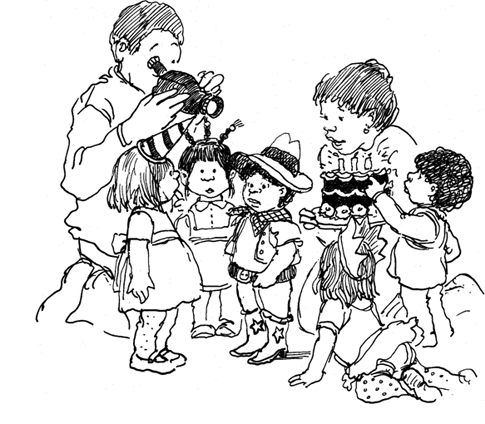 period. Invite everyone to meet again. period. Invite everyone to meet again.
Reevaluate at the end of the trial period.
If the solution worked, great. If not, try another one. These meetings do not have to be formal; they can take place casually at mealtime.
Three-year-olds love rituals.
Rituals, such as family meals, holiday celebrations, and birthday parties, are important to children at this age. Rituals help children get a sense of the rhythm of the year and learn how to participate in family traditions. If you have special traditions you want your child to learn, be a part of making them happen. Discuss ideas at family meetings. Don't leave everything up to your wife. If you don't like the rituals you grew up with, think creatively as a family about establishing new ones.
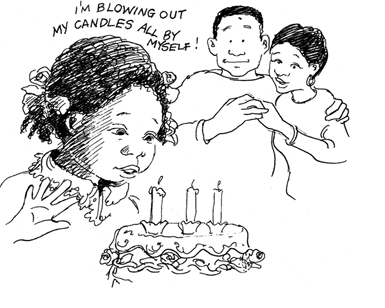 Celebrating a Third Birthday Celebrating a Third Birthday
As with all celebrations that you want toddlers to enjoy, don't make your plans too lavish. Think back. Do you remember your third birthday party? Hardly anyone does. So, instead of trying to make the most memorable party ever, concentrate on the tried-and-true pleasures of life. Food: Serve ice cream cones first and then cupcakes. Serve small cans or boxes of apple juice. Sit in a circle and play finger play games with the children. Ask them which ones to play. Sing songs with them; again, asking for requests. Roll a ball back and forth, and then go on a follow-the-Ieader march. For treats to send home, you might give out animal crackers, toy horns, and party hats.
Riding Toys with Pedals 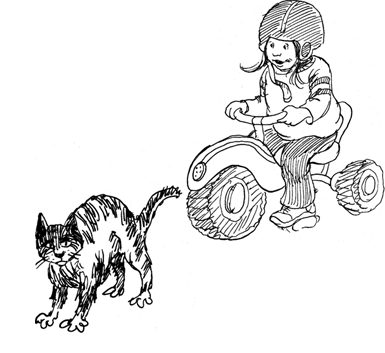
Most three-year-olds can learn to pedal tricycles by themselves. But tricycles today come in different sizes and shapes. Some are just too big for three-year-olds to handle. If you are going to buy one for your child, have your child try out different vehicles in the store before deciding which one to purchase. You can also ask other children on the playground to let your child try out their trikes.
Watch for trikes at tag sales; often you can get good ones very inexpensively this way.
Construction Vehicles
Good sturdy construction trucks that work with real sand and dirt give children hours of outside pleasure. They like to pretend with these vehicles that they are grown-ups building things. Toy wheelbarrows are also appreciated for transporting dirt, stones, dolls, and other toys around. The next time you pass a construction site with your child, stop and look together at what's happening. You may see your child later imitate through play some of the workers.
Rough & Tumble Play
Many dads like to roughhouse with their children, who delight in this kind of play as long as you are not too rough and you stop when they want you to. Roughhousing with toddlers should not really be rough at all. It's just a matter of your lifting them up, swinging them down, twirling them around, and so forth always safely and with their enjoyment clear.
The 2 worst times for roughhousing:
1. Before meals
2. Before bed
If you roughhouse with a child before meals, your child will not eat. If you roughhouse before bedtime, your child will not sleep. Think about it.
Time Out
Time Out refers to the practice of separating a child from a situation in which he or she is misbehaving. It is somewhat similar to Going to Your Room. Telling a child to "go to your room" is generally an angrier admonition than telling a child to take time out.
A child sent to his or her room feels banished; while a child sent to sit on a certain chair and take time out is being given a chance to rest and get a grip on his or her behavior. Time Out lasts for five or ten minutes; it doesn't need to be long. If the Time Out child falls asleep, then you know what the problem was.
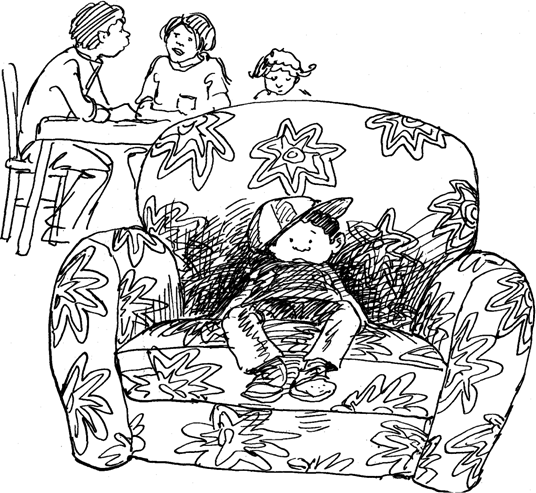
Making Presents
Young children can put their artistic talents to use by making things to give to people as presents. Toddlers are not yet skilled in all the arts, but they can make a few things quite decently.
Bead necklaces.
See Chapter 3 for information on beads. When children are younger, you have to help them string beads. Most three-year-olds are now able to string four beads by themselves. As your child gives away bead necklaces, replenish the supply of beads and strings.
Bouquets of flowers. 
Save flower baskets from floral arrangements. Throw away the dead flowers and dry out the green spongy thing inside. When your child is ready to make a bouquet, wet the sponge thoroughly. Supply your child with flowers that have sturdy stems. Your child can stick them into the green sponge and make a beautiful bouquet.
Drawings.
Keep an assortment of inexpensive plastic frames on hand to display your child's drawings for gifts.
Giving Presents
It's nice to offer your child the opportunity to give homemade presents to people. Grandparents love to receive presents from their grandchildren; this is one way to pay them back for their help. But there are others, too, who appreciate a kind gesture from a child: teachers, librarians, parents of newborns, and new children in the neighborhood. By giving gifts, children can learn at an early age the rewards of generosity.
Building a Bridge From Blocks
Show your child how to build a simple bridge with blocks. First, put two blocks down, separated by a little space. Then put another block on top. Describe what you are doing, concluding, "And that makes a bridge. Can you build one like it?" Your child is probably old enough now to understand what you did, to remember it, and to now be able to build a bridge like yours.
In the same way, you can show your child how to build other structures, such as a little house - perhaps with a square block and a triangle roof. Don't get too complicated. Pay attention to what your child can and can't do. Offer only enough suggestions to make things interesting, not discouraging.
Blocks Last a Long Time
While your child may not be able to make complex structures with blocks now, your child will grow more adept as time goes on. Blocks are expensive, but they are a good investment because they lend themselves to creative expression and logical thinking. Block play can last well into second grade and beyond.
Blocks enable children to represent the world around them. As children grow, they represent the world with more complexity. For example, a kindergartener who visits the zoo can come home and build a zoo with blocks. To encourage the benefits that blocks provide, help your child play with them. When your child builds an especially interesting block structure, leave it up for a while. Take a picture of it with your child in the picture. Start a photo gallery on the refrigerator to display the block structures your child makes.
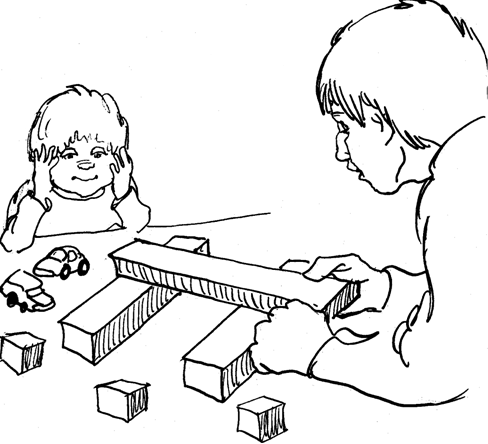
Taking Turns
Learning to share and take turns is one of the most important achievements of childhood. It does not come easily, but the process of learning to share begins when children are toddlers. Three-year-olds are capable of waiting in line for a snack if the line isn't too long, and they are capable of waiting for a toy or their turn in a game if the wait isn't too long.
Little Brats
Sometimes as a parent you may have the experience of watching your child wait valiantly for his or her turn to come, only to be stymied by a perfectly wretched little brat who will not give up what your child has been waiting for. What can you do?
You can try to talk the bratty child out of the toy, perhaps by offering something else that is quite desirable.
You can take the role of enforcer by taking the toy away from the brat and saying, "It's not your turn any longer. Come, I'll help you find something else to enjoy." If the bratty child proves to be utterly intransigent, you might just want to take your child and go off to another part of the playground or playroom.
Be a little sympathetic toward the wretch who has spurned your child, however, because another day that child could be your child. Rare is the toddler who doesn't get selfish from time to time.
Feeding Myself Rather Nicely 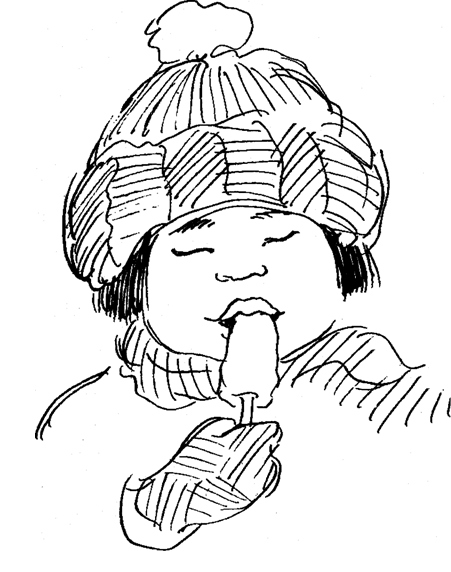
Toddlers have come a long way as far as feeding themselves. They are now skilled at using both forks and spoons, they can drink from a cup, they can sip from a straw, and they can eat a Popsicle. They can even take a napkin and wipe their mouths.
Going to Restaurants
Three-year-olds are not the world's worst dinner companions. They can sit up in a high chair and eat properly. They like to look at the other people in a restaurant. They seem to enjoy the restaurant scene and often are cute enough to receive special attention from waiters and waitresses.
But don't make the mistake of going to a fancy, expensive restaurant with a three-year-old. Unless the restaurant has fallen on hard times, you won't be welcome, and the restaurant probably won't have a nice, comfortable, safe, and clean high chair for your child. Fast-food restaurants, such as McDonald's and Burger King, accommodate children easily. Italian, Mexican, and Chinese restaurants are usually friendly to toddlers, too, but don't go when your child is tired and whiny, and do bring along a few little toys.
Understanding Explanations
Three-year-olds can understand reasonable explanations, so tell them in simple terms where you go when you go to work and that, indeed, you love them all day long. Don't apologize for working. Explain, again in simple terms, that you have to work so that you will have money to buy food and clothes and toys. Don't ask, "Can I go to work now?" That's not up to your child. Instead, say, "I'm going to work now, and I'll think of you all day long."
Cooperation
Children can be impossible in grocery stores, there's no doubt about it. However, they can also be helpful, especially if you encourage this trait. Let them reach out and grab certain things, but set limits on this behavior. For example, when you enter the store, you can say, "When we find your snack, you can carry it." Then let your child look for it, and when you find it, carry it.
Cutting with Scissors
Three-year-olds can begin to learn how to cut little pieces of paper with scissors. You can help them by placing your hand over your child's hand and then cutting. Your child can't use grown-up scissors; they are too big. You need to get a pair of small children's scissors. You can buy them in pharmacies and craft stores. Children's scissors have blunted ends for safety. Right from the beginning, teach your child never to run with scissors and to put them away in a special place when finished.
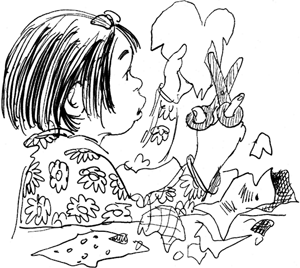
My First and Last Name
Children can now learn to say both their first and last name in response to the question, "What's your name?" You can show your child how to write his or her initials or name, too. Sometimes children can learn to recognize their name, if it's short, not by reading it but by memorizing the shapes the letters make.
Playing Baby
As children grow, they seem to take two steps forward and one step backward. Sometimes they act so babyish you wonder what's wrong. Nothing's wrong. They're just making a nostalgic trip back to babyhood. Maybe they need a little more of the kind of cuddling they remember getting when they were babies and that they see other babies getting. Don't be concerned when your child acts this way. We all do it from time to time.
Playing Gown-Up
Other times, your three-year-old will seem to work at a job like a grown-up, especially if you are nearby, occasionally helping and offering praise. Children like independence as well as dependence, and you need to supply opportunities for them to experience both. Gradually as they grow, they become more and more independent. This kind of back-and-forth progress is natural.
My Vocabulary Grows to 1,000 Words!
Of all the things that toddlers learn, language is the most remarkable. Think of it: At age one a child can say only two or three words, but at age three the same child understands up to a thousand words. A three-year-old can use words to ask questions, give explanations, describe things, express feelings, greet people, fantasize, and sing.
But knowing many words does not necessarily give children the ability to communicate. They have to learn to pronounce them, to make mistakes, to construct sentences that get more and more elaborate, and to listen.
Young children have to want to use words, want to talk, and feel that others want to talk with them. That's where you come in. By continuing to talk with your child, you convey on an ongoing basis the sense that communication between people is a vital part of life.
Communication & Friendship
Your child is now able to tell you about things that have happened to him or her. The accounts may be halting and inarticulate, but listen. And comment. Sometimes all you have to do is say back what your child is saying to show you understand.
If you are away from home on a trip, take time to talk to your child on the phone. Be patient because your child may not be able to say much on the phone. The open and friendly communication patterns that you establish now will serve you well in 20 years when you two drop your parent/child roles and become good friends.
Storytelling
Children like to listen to stories that you read to them and that they hear on tape. Sometimes they want to tell these stories back to you, and they can do this surprisingly well, especially if you know the story and help them along. From time to time, listen to your child's favorite stories on tape in the car. That way you'll both know the same stories.
 Learning How to Behave Learning How to Behave
In general, three-year-olds are a bit more civilized than two-year-olds. They like to behave properly, but often don't know how. When you take your child into a new situation, explain how people will act and what you expect. For example, you might say the first time you take the train together, "People on the train like to be quiet because they are tired. So we will read together quietly. When we get home, I will read a book to you out loud. " Your child will be able to look at books quietly only for a short while, so you need to have other things for him or her to play with on the train, too.
A Strong Desire to Learn
Since toddlers learn by doing, you have to keep a close eye on them to make sure that their explorations and activities don't get them into trouble. This may seem like a lot of work, but letting them loose is worse and far more dangerous.
How to Teach a Toddler
The home is the child's first school, and you are one of your child's first teachers, but that doesn't mean that you need to be a strict schoolmaster. The kind of education that is needed in the home is a gentle, joyous, and casual kind of education that goes on as naturally as conversation and play. For that is precisely it: conversation and play are the two main ingredients of high-quality education for toddlers.
Four tips for teaching toddlers effectively.
1. Watch.
To teach your child in the best way, you must first learn to identify and support your child's investigations. Observe your child to see what he or she is interested in at the moment. Whatever it is, allow your child to find out more about it, provided the investigations are safe - for your child, other people, and your home.
2. Talk.
Talk about whatever it is that interests your child. Name it, describe it, ask questions. Talk with your child, not at him or her. Don't overdo it. Try to guess what your child would like you to say or tell about. If you think he or she would like you to be quiet, be quiet.
3. Introduce new experiences at the right moment. 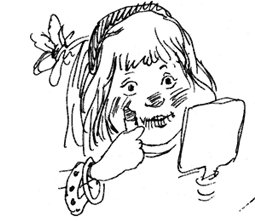
If your child is absorbed in watching the cat, don't distract him or her by calling attention to a new ball. Wait until an appropriate moment comes.
4. Don't be pushy.
Enjoy your child and your child's interests. Don't insist that your child be interested in something else, for your sake. On the contrary, try to interest yourself in your child's interests, for your child's sake. If you feel bored with your child's interests, try to see them through your child's eyes, not your own. Assuming the perspective of a child can be a mind-opening and very stimulating experience.
Self-Esteem
Your self-esteem affects your child's self-esteem. What you feel about yourself is an important part of what you convey each day to your child about people and life. The more you feel a sense of your own worth, the less apt you will be to use your child to compete for you and make you happy.
Don't neglect yourself: As you take care of your child's emotional, physical, and educational growth, take care of those parts of yourself, too. Give yourself rights as a person: even the right to resent being a parent sometimes. Give your wife those rights, too.
Compassion for Others
Children imitate grown-ups. Those lucky children who regularly see grown-ups comforting children and each other are bound sooner or later to imitate that behavior. That's why it is not unusual to see toddlers express compassion toward one another. One child cries, and another comes over to give a hug. When you see this, you know you're doing a good job as a parent.
Art, Fantasy & Reality
Young children live in two worlds: the world of fantasy, in which monsters and princesses can scare them and reassure them, and the world of reality, in which real people can scare them and reassure them. Separating the two worlds is one of the tasks of childhood, and it takes many years. Usually by the time children are seven or eight, they are able to do so with confidence.
But before that, children live in both worlds, and that makes life both confusing and wonderfully rich for them. Literature, art, dance, and music are, as always, among the best ways for children to experience both fantasy and reality. Children don't need lessons in these areas as much as they need time, good art materials, space to dance and move in, and creative adults who sympathize with their artistic and scientific explorations. Be one of those people for your child, and let your child's imagination bring back to you some of the enchantment of childhood.
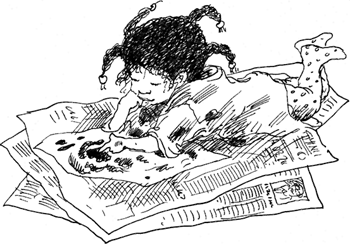
Congratulations!
Congratulations on being a father of a three-year-old child. Think back to your three-year-old as a brand-new infant, and marvel at how far your child has come. Your ballet dancer may be able to balance on one foot for about two seconds. Bravo!
Your three-year-old also may be able to kick a ball about 10 feet. Hooray! Your child may enjoy playing with other children and like learning from them. Yes! All of which gives you immense joy and a feeling of unbounded pride, which you can share with other parents of threes who undoubtedly feel exactly the same way.
You're the Father of a Three-Year-Old
Think back three years ago to yourself as a new father, and marvel at how far you've come, too. That's three long years of parenting, during which time you have developed skills you probably never knew you had within you to learn. There is no one style of parenting that works better than all others, provided that love and consistency are part of the overall approach. You have developed your style, and it fits your child just right.
What Not to Expect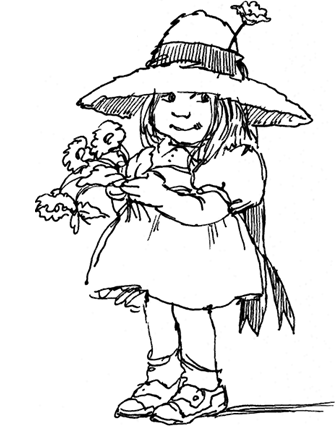
Don't expect your three-year-old to be all grown up. Parents who dreaded the terrible twos are sometimes disappointed in the so-called better threes. Three-year-olds can be like two-year-olds-often. Threes still like to make play dough. Sorry, but they are not ready yet for French cooking.
What to Expect
Expect three-year-olds to continue to be active investigators of life. Expect them to express their feelings much of the time, and to enjoy playing with familiar children and interested adults. If you worry that your child is too passive, too uninterested in others, and too reluctant to verbalize feelings, you may want to ask your pediatrician or the local public elementary school administrator for information on programs to help preschoolers with learning disabilities, specific and identifiable neurological or emotional problems. Some three-year-olds have physical handicaps, such as deafness or blindness, that can impair their progress. Many cities and towns have wonderful special programs for children with special needs.
Most of all, expect your child to be your child - nobody else's and nobody else. Expect that your love for your child will continue to grow and grow.
CLICK TO RETURN TO THE INDEX
|

